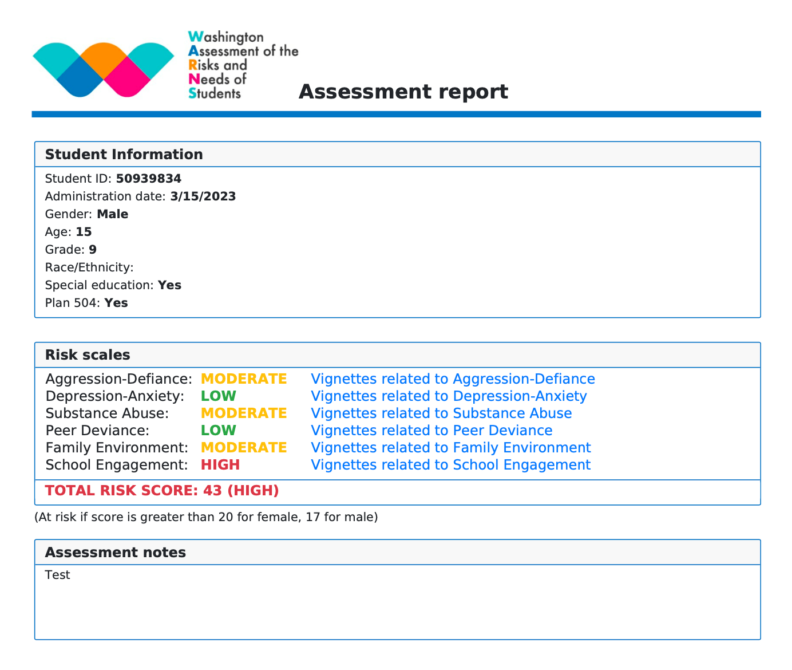What is WARNS?
Dr. Tom George developed the WARNS and conducted initial validation studies at the Washington State Center for Court Research, an effort funded by a grant to the Center from the John D. and Catherine T. MacArthur Foundation. Development of the WARNS instrument began in the summer of 2008 in Washington State with discussions among juvenile justice professionals about the need for a risk and needs assessment for status offenders and low-level juvenile criminal offenders.
The WARNS was modeled after the widely used and validated Washington State Juvenile Court Assessment for juvenile offenders (2004 Washington State Juvenile Court Assessment Manual by Robert Barnoski). However, the need for an easily administered instrument, with the potential for use with a large number of youth, led to the development of a brief self-report instrument which could be administered efficiently and economically on a large-scale basis.
The domain and item development process began with a review of the research literature on correlates and predictors of truancy, delinquency, and dropping out of school. This included a review of validated research and clinical instruments developed to assess juvenile offending, child and adolescent psychopathology, and educational engagement and outcomes.
Based on these reviews, areas of assessment were identified that would appropriately address youths’ risks for problematic outcomes as well as their social and emotional needs. Finally, items were developed to assess these risk factors.
There are six Needs Scales in the WARNS instrument, each consisting of between five and nine questions, for a total of 40 questions. All six areas have been liked to truancy, delinquency, and/or dropping out of school. Scores on a scale are used to determine weather a youth has a “Low,” “Moderate,” or “High” need for intervention in that area. The six scales consist of the following:
| Aggression-Defiance | Substance Abuse | Family |
| Depression-Anxiety | Peer Deviance | School |
The Aggression-Defiance scale refers to the tendency to act out one’s distress in an aggressive, irritable, and defiant manner. The Depression-Anxiety scale, on the other hand, assesses levels of internalizing behaviors, which tend to take the form of depression and anxiety, and may result in intensive sadness, hopelessness, sleeping and eating problems, and more. The Substance Abuse scale screens for the frequency of alcohol, marijuana, and “hard drug” use.
The other needs scales assess a youth’s functioning in three critical social contexts. Peer Deviance assesses a variety of problematic behaviors among the youth’s friends, Family Environment focuses on a youth’s relationships with their parents and home environment, and School Engagement assesses how much students like going to school, and their engagement with the educational environment.
A detailed individual-level report (referred to as a WARNS Report) is available immediately following online administration. They can be printed and/or saved digitally in many formats to the device used for administration. In addition, reports may be saved to a secure storage device.
The WARNS Report contains the youth’s identification number and demographics at the top of the report. Next, the level of need is presented for each of the six Needs Scales. The levels of need are color coded for quick and easy identification. Following the Needs Scales, information from every item on the survey can be presented and organized by the content of the items, depending on the administration option that was chosen. If the user has requested “Anonymous Administration,” then only the demographics and Needs Scale scores will appear at the end of the report.
For counselors, case managers, and other individuals working with at-risk youth, the WARNS Report provides a way to quickly gather and synthesize important information about a youth’s developmental experiences and current functioning. It is best used during the initial stages of engagement with the youth to better understand their specific risks and needs.

This report is a way to facilitate and guide conversations, and develop a successful intervention plan. Counselors have reported that youth appreciate knowing how they score in each domain and often volunteer information that they would not have provided under a normal conversation with a school official.
A vignette library is available for hsWARNS Reports. WARNS administrators, such as school counselors and psychologists, can use the vignettes as a way to facilitate discussion with the student. Administrators can select a narrative based on the youth’s domain scores. The vignettes allow the students and WARNS administrators to discuss fictional scenarios that may be similar to where the youth is at greatest risk to help the student think through their specific issues.